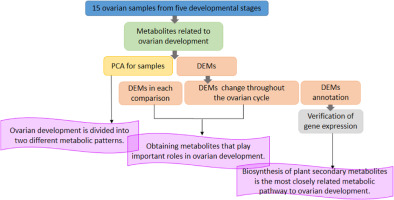当前位置:
X-MOL 学术
›
Comp. Biochem. Physiol. D Genom. Proteom.
›
论文详情
Our official English website, www.x-mol.net, welcomes your
feedback! (Note: you will need to create a separate account there.)
Comparative metabolomics analysis of ovarian developmental stages in Macrobrachium nipponense.
Comparative Biochemistry and Physiology D: Genomics & Proteomics ( IF 2.2 ) Pub Date : 2020-01-29 , DOI: 10.1016/j.cbd.2019.100648 Yuning Zhang 1 , Yin Fu 2 , Sufei Jiang 3 , Hui Qiao 3 , Yiwei Xiong 3 , Hongtuo Fu 4 , Wenyi Zhang 3 , Yongsheng Gong 3 , Shubo Jin 3 , Yan Wu 3
Comparative Biochemistry and Physiology D: Genomics & Proteomics ( IF 2.2 ) Pub Date : 2020-01-29 , DOI: 10.1016/j.cbd.2019.100648 Yuning Zhang 1 , Yin Fu 2 , Sufei Jiang 3 , Hui Qiao 3 , Yiwei Xiong 3 , Hongtuo Fu 4 , Wenyi Zhang 3 , Yongsheng Gong 3 , Shubo Jin 3 , Yan Wu 3
Affiliation

|
Rapid sexual maturity of female Macrobrachium nipponense is a severe problem for the aquaculture industry. To date, there have been only transcriptome studies investigating ovarian development, and studies using other tools, such as metabolomics are lacking. Metabolomics reveals changes in the level of metabolites in tissues in relation to current physiological characteristics, and can yield valuable insight into the growth and development of organisms. In this study, we systematically analyzed 15 samples from five different ovarian developmental stages in M. nipponense to learn more about how metabolites change over reproduction. Gas chromatography/time-of-flight mass spectroscopy revealed an array of different compounds and 83-162 pathways depending on the stage. Furthermore, 89 metabolites and 14 pathways were significantly different across stages. It is hypothesized that N-acetyl-N-formyl-5-methoxykynurenamine, ascorbate, fructose-2,6-bisphosphate, cortexolone and other metabolites that significantly differed by stage are regulated by hormones and are closely related to ovarian development. However, for other metabolites that changed with development, such as cytidine and xanthine, an association with ovarian development has yet to be revealed. Quantitative polymerase chain reaction was used to correlate gene changes to metabolites in the pathway for biosynthesis of plant secondary metabolites. We found that the TCA cycle rate may be the cause of female miniaturization during the reproductive period, and that the control of fatty acid content via aquaculture nutrition may be an exogenous tool for regulatory control of maturation. This study provides a systematic and comprehensive metabolomics analysis of ovarian development in M. nipponense and lays a foundation for addressing the problem of rapid sexual maturity.
中文翻译:

日本沼虾卵巢发育阶段的比较代谢组学分析。
雌性日本沼虾的快速性成熟对于水产养殖业是一个严重的问题。迄今为止,仅进行了转录组研究来研究卵巢发育,而缺乏使用其他工具(例如代谢组学)的研究。代谢组学揭示了组织中代谢物水平与当前生理特征相关的变化,并可以提供有关生物生长和发育的有价值的见识。在这项研究中,我们系统地分析了日本分枝杆菌五个不同卵巢发育阶段的15个样本,以了解有关代谢产物如何在繁殖过程中变化的更多信息。气相色谱/飞行时间质谱揭示了一系列不同的化合物,并根据阶段显示了83-162个途径。此外,在各个阶段中,有89种代谢物和14种途径存在显着差异。据推测,N-乙酰基-N-甲酰基-5-甲氧基kynurenamine,抗坏血酸盐,果糖-2,6-双磷酸酯,皮质酮和其他代谢物在阶段上有显着差异,它们受激素调节,并且与卵巢发育密切相关。但是,对于其他随着发育而变化的代谢物,例如胞苷和黄嘌呤,与卵巢发育的关联尚待揭示。定量聚合酶链反应用于将基因变化与植物次生代谢产物生物合成途径中的代谢产物相关。我们发现,TCA循环速率可能是生殖期女性体型缩小的原因,并且通过水产养殖营养控制脂肪酸含量可能是调控成熟的外在工具。这项研究提供了一个系统的,全面的代谢组学分析的日本乳杆菌的卵巢发育,并为解决快速性成熟的问题奠定了基础。
更新日期:2020-01-29
中文翻译:

日本沼虾卵巢发育阶段的比较代谢组学分析。
雌性日本沼虾的快速性成熟对于水产养殖业是一个严重的问题。迄今为止,仅进行了转录组研究来研究卵巢发育,而缺乏使用其他工具(例如代谢组学)的研究。代谢组学揭示了组织中代谢物水平与当前生理特征相关的变化,并可以提供有关生物生长和发育的有价值的见识。在这项研究中,我们系统地分析了日本分枝杆菌五个不同卵巢发育阶段的15个样本,以了解有关代谢产物如何在繁殖过程中变化的更多信息。气相色谱/飞行时间质谱揭示了一系列不同的化合物,并根据阶段显示了83-162个途径。此外,在各个阶段中,有89种代谢物和14种途径存在显着差异。据推测,N-乙酰基-N-甲酰基-5-甲氧基kynurenamine,抗坏血酸盐,果糖-2,6-双磷酸酯,皮质酮和其他代谢物在阶段上有显着差异,它们受激素调节,并且与卵巢发育密切相关。但是,对于其他随着发育而变化的代谢物,例如胞苷和黄嘌呤,与卵巢发育的关联尚待揭示。定量聚合酶链反应用于将基因变化与植物次生代谢产物生物合成途径中的代谢产物相关。我们发现,TCA循环速率可能是生殖期女性体型缩小的原因,并且通过水产养殖营养控制脂肪酸含量可能是调控成熟的外在工具。这项研究提供了一个系统的,全面的代谢组学分析的日本乳杆菌的卵巢发育,并为解决快速性成熟的问题奠定了基础。











































 京公网安备 11010802027423号
京公网安备 11010802027423号